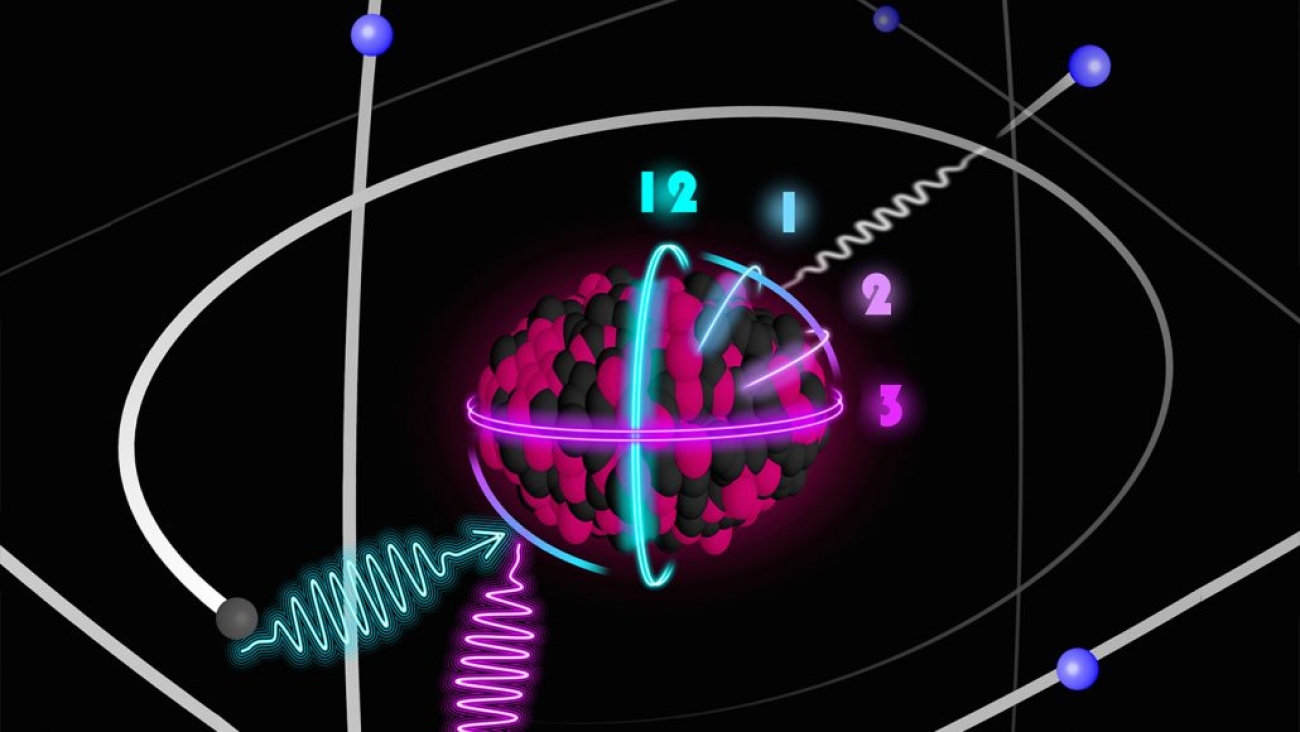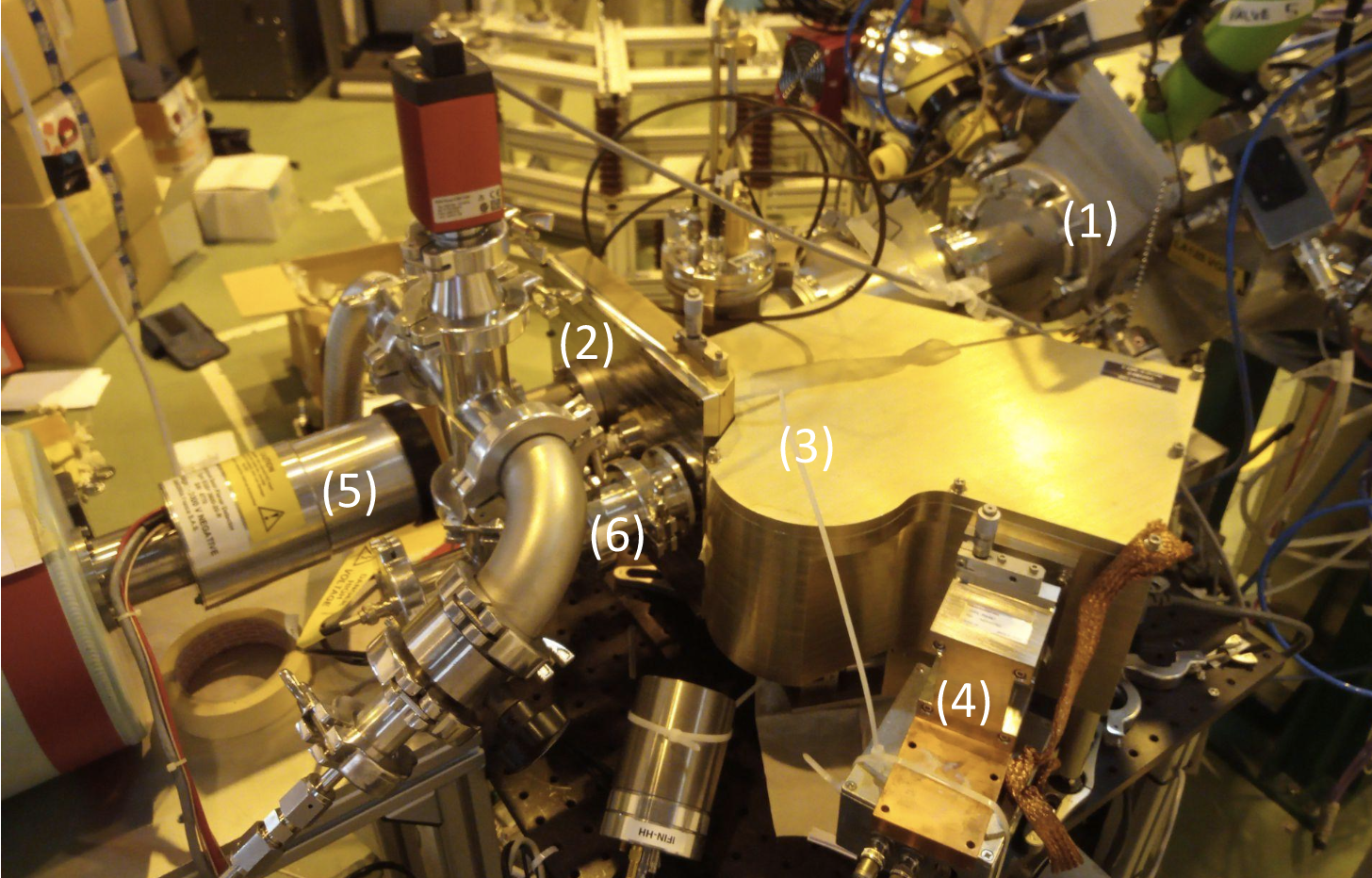Radioactive ion beams at ISOLDE bring the nuclear clock a tick closer

The precise measurement of time and frequencies has always played an important role in the history of science. Since the adoption of the caesium-133 standard as the definition of the second within the Système International (SI) in 1967, a network of atomic clocks delivers precise measurement of time. While first atomic caesium clocks in the early days driving radio frequency transitions showed a fractional uncertainty of 2 x 10-10, new types of clocks with transitions in the optical region of the electromagnetic spectrum and introduction of new techniques such as laser cooling and frequency combs increased clock performance to accuracies entering the 1x10-19 regime.
The fractional uncertainties are eventually limited by environmental influences. Replacing an atomic with a nuclear transition reduces these effects as the magnetic and electric moments of the nucleus are significantly smaller. In such a nuclear clock, based on the nucleus of thorium-229, the transition between a nuclear ground state and an isomeric state (i.e., with a sufficiently long half-life) is driven as a frequency standard. This idea was substantiated by Peik and Tamm in 2003 in a detailed concept and later found to enable competitive fractional uncertainties in the 10-19 regime [1,2]. Two different main approaches are pursued for the nuclear clock (see e.g. [3] and references therein): Using a few thorium ions in a radio-frequency trap, highest accuracies are achieved on the one hand. On the other hand, a solid-state nuclear clock places a large number of more than 1015 nuclei in a crystalline medium transparent for the excitation photons.
Two main differences offer additional unique prospects for future applications of a nuclear clock as compared to atomic clocks. First, the time within which the accuracy limit can be reached, called stability of the clock, depends on the number of interrogated transitions. While its ultimately achievable accuracy is limited by field gradients stemming from the crystalline environment, highest stability is reached in a solid-state design within orders of magnitude faster times than in ion-trap-based clocks interrogating a single or few two-level systems at the time.
On the other hand, a nucleus couples to additional fundamental forces of the standard model compared to an electron. The coupling strength to the electromagnetic force is given by the fine structure constant α, the strong force coupling constant αS etc and are postulated within the Standard Model to be constant in time. Comparing the frequency of a clock that is based on an electronic transition and governed by the electromagnetic interaction only and a clock that is based on a nuclear transition, where hadronic forces play an additional role, allows to identify subtle changes in the fine structure constant. Experimental observation of temporal variations would directly hint to new physics. Ultralight dark matter is discussed as one of the origins of such time-variations and synchronized clock networks could additionally give access to topological distributions of dark matter candidates.
While first evidence for the low-energy isomer in thorium stems from the mid-seventies, the direct proof of existence has been achieved only recently and triggered a series of successful experiments characterizing the isomer’s excitation energy, lifetime of the internal conversion channel and nuclear moments [4,5,6,7]. The observation of the gamma decay of the isomeric state remained, however, technically challenging and a dark spot of the research field grown around this particular isomer. Experiments are impeded by the interaction with the chemical environment, potentially favouring the non-radiative internal-conversion over the gamma-decay channel.
Experiments performed by an international collaboration at CERN’s ISOLDE facility uses the availability of exotic radioactive ion beams that allow to increase the population of the isomer significantly [8]. A short-lived β-decay chain feeding the radioisotope actinium-229 is implanted into large-bandgap crystal materials such as magnesium-fluoride and calcium-fluoride. Actinium with its half-life of roughly one hour populates in its β-decay subsequently the low energy isomer thorium-229 at least seven times more efficiently than uranium-233. A vacuum-ultraviolet spectroscopy setup with high numerical aperture developed for this experiment is sketched in figure 1.

Figure 1: The vacuum-ultraviolet-spectroscopy setup installed at the LA1 beamline at ISOLDE. The ISOLDE beamline (1), implantation target wheel chamber (2), grating monochromator (3), photomultiplier tube detector (4), γ-detector (5) and wavelength calibration light source (6) can be seen.
Wavelength spectra recorded with different implantation crystals (see figure 2) all show a peak at about 148 nm identified as the radiative decay of the thorium-229m isomer. Reference measurements with a similar β-decay chain from actinium-230 are lacking such a feature (figure 2, right panel). The observed signal enabled the measurement of both the lifetime in a magnesium fluoride medium and the wavelength of the emitted photons directly related to the excitation energy of the isomer. The result is in good agreement with previous studies while improving the so far reported uncertainty by a factor of seven [4,5].

Figure 2: Wavelength spectra recorded with a b-decay chain (A=229) including the isomer (left panel) and a similar b-decay chain (A=230) without any known low-energy isomer (right panel) for implantations in magnesium-fluoride (red), calcium-fluoride (blue) and thin-film calcium-fluoride (green). The photons from the radiative decay of the thorium-229 isomer are visible as a peak in the left panel around 148 nm. The black lines show the expected peak for a non-nuclear effect under comparable conditions. Reproduced from https://doi.org/10.48550/arXiv.2209.10276.
Direct laser excitation of the thorium-229m isomer, serving as the basis for a nuclear optical clock, is currently limited by the availability of high-power vacuum-ultraviolet lasers at about 148 nm. The quest for an all-optical excitation of the nuclear state thorium-229m requires long scanning times to cover the uncertainty range of the literature value, which is significantly reduced by this study. Future measurements of the excitation energy using vacuum-ultraviolet spectroscopy at ISOLDE have the potential to reduce this scanning time further. However, the observation of the gamma decay is not only opening the door to investigate the excitation energy more precisely, but it also proves that a sufficient control over the chemical environment in a crystal can be achieved in order to prevent the internal conversion channel from dominating over the radiative decay. This is a crucial result for the development of a solid-state nuclear clock. In the future, CERN’s radioactive ion beam infrastructure will help to efficiently check a broad range of different crystal candidates for such a device.
In the longer term, table-top experiments such as experiments comparing nuclear with atomic clocks can complement dark matter searches performed at the high-energy frontier by the exclusion of candidates in the ultra-low mass regime.
An article resulting from this study and accepted for publication in Nature is available as a preprint on arXiv, https://arxiv.org/abs/2209.10276
References
[1] Peik, E., and Chr Tamm. “Nuclear Laser Spectroscopy of the 3.5 EV Transition in Th-229.” EPL (Europhysics Letters) 61, no. 2 (January 2003): 181. https://doi.org/10.1209/epl/i2003-00210-x.
[2] Campbell, C. J., A. G. Radnaev, A. Kuzmich, V. A. Dzuba, V. V. Flambaum, and A. Derevianko. “Single-Ion Nuclear Clock for Metrology at the 19th Decimal Place.” Physical Review Letters 108, no. 12 (March 22, 2012): 120802. https://doi.org/10.1103/PhysRevLett.108.120802.
[3] Peik, E., T. Schumm, M. S. Safronova, A. Pálffy, J. Weitenberg, and P. G. Thirolf. “Nuclear Clocks for Testing Fundamental Physics.” Quantum Science and Technology 6, no. 3 (April 2021): 034002. https://doi.org/10.1088/2058-9565/abe9c2.
[4] Seiferle, Benedict, Lars von der Wense, Pavlo V. Bilous, Ines Amersdorffer, Christoph Lemell, Florian Libisch, Simon Stellmer, et al. “Energy of the 229Th Nuclear Clock Transition.” Nature 573, no. 7773 (September 2019): 243–46. https://doi.org/10.1038/s41586-019-1533-4.
[5] Sikorsky, Tomas, Jeschua Geist, Daniel Hengstler, Sebastian Kempf, Loredana Gastaldo, Christian Enss, Christoph Mokry, et al. “Measurement of the $^{229}\mathrm{Th}$ Isomer Energy with a Magnetic Microcalorimeter.” Physical Review Letters 125, no. 14 (September 28, 2020): 142503. https://doi.org/10.1103/PhysRevLett.125.142503.
[6] Seiferle, Benedict, Lars von der Wense, and Peter G. Thirolf. “Lifetime Measurement of the 229mTh Nuclear Isomer.” Physical Review Letters 118, no. 4 (January 26, 2017): 042501. https://doi.org/10.1103/PhysRevLett.118.042501.
[7] Thielking, Johannes, Maxim V. Okhapkin, Przemysław Głowacki, David M. Meier, Lars Wense, Benedict Seiferle, Christoph E. Düllmann, Peter G. Thirolf, and Ekkehard Peik. “Laser Spectroscopic Characterization of the Nuclear-Clock Isomer 229m Th.” Nature 556, no. 7701 (April 2018): 321–25. https://doi.org/10.1038/s41586-018-0011-8.
[8] Verlinde, M., S. Kraemer, J. Moens, K. Chrysalidis, J. G. Correia, S. Cottenier, H. De Witte, et al. “Alternative Approach to Populate and Study the 229Th Nuclear Clock Isomer.” Physical Review C 100, no. 2 (August 12, 2019): 024315. https://journals.aps.org/prc/pdf/10.1103/PhysRevC.100.024315
